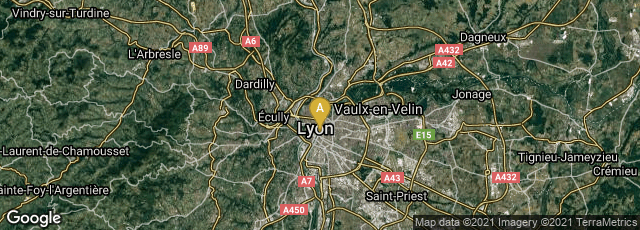

A: Lyon, Auvergne-Rhône-Alpes, France
In 1839 weaver Michel-Marie Carquillat, working for the firm of Didier, Petit et Cie, in Lyon, France wove in fine silk a Portrait of Joseph-Marie Jacquard, The image, including caption and Carquillat’s name, taking credit for the weaving, measures 55 x 34 cm.; the full piece of silk including blank margins measures 85 x 66 cm.
This image, of which perhaps only about 20 examples survived, was woven on a Jacquard loom using 24,000 Jacquard cards, each of which had over 1000 hole positions. The process of mis en carte, or converting the image details to punched cards for the Jacquard mechanism, for this exceptionally large and detailed image, would have taken several workers many months, as the woven image convincingly portrays superfine elements such as a translucent curtain over glass window panes.
The Jacquard loom did no computation, and for that reason it was not a digital device in the way we think of digital today. However the method by which Jacquard stored information in punched cards by either punching a hole in s standardized space in a card or not punching a whole in that space is analogous to a zero or one or an on and off switch. It was also an important conceptual step in the history of computing because the Jacquard method of storing information in punched cards, and weaving a pattern by following the series of instructions recorded in a train of punched cards, was used by Charles Babbage in his plans for data and program input, and data output and storage in his general purpose programmable computer, the Analytical Engine![]() . Trains of Jacquard cards were programs in the modern sense of computer programs, though the word "program" did not have that meaning until after the development of electronic computers after World War II.
. Trains of Jacquard cards were programs in the modern sense of computer programs, though the word "program" did not have that meaning until after the development of electronic computers after World War II.
Once all the “programming” was completed, the process of weaving the image with its 24,000 punched cards would have taken more than eight hours, assuming that the weaver was working at the usual Jacquard loom speed of about forty-eight picks per minute, or about 2800 per hour. More than once this woven image was mistaken for an engraved image. The image was produced only to order, most likely in an exceptionally small number of examples. In 2012 the only publically recorded examples were those in the Metropolitan Museum of Art, the Science Museum, London, The Art Institute of Chicago, and the Computer History Museum, Mountain View, California. The image was the subject of the book by James Essinger entitled, Jacquard's Web. How a Hand Loom led to the Birth of the Information Age (2004).
To Charles Babbage the incredible sophistication of the information processing involved in the mis en carte — what we call programming— of this exceptionally elaborate and beautiful image confirmed the potential of using punched cards for the input, programming, output and storage of information in his design and conception of the first general-purpose programmable computer—the Analytical Engine. The highly aesthetic result also confirmed to Babbage that machines were capable of amazingly complex and subtle processes—processes which might eventually emulate the subtlety of the human mind.
“In June 1836 Babbage opted for punched cards to control the machine [the Analytical Engine]. The principle was openly borrowed from the Jacquard loom, which used a string of punched cards to automatically control the pattern of a weave. In the loom, rods were linked to wire hooks, each of which could lift one of the longitudinal threads strung between the frame. The rods were gathered in a rectangular bundle, and the cards were pressed one at a time against the rod ends. If a hole coincided with a rod, the rod passed through the card and no action was taken. If no hole was present then the card pressed back the rod to activate a hook which lifted the associated thread, allowing the shuttle which carried the cross-thread to pass underneath. The cards were strung together with wire, ribbon or tape hinges, and fan-folded into large stacks to form long sequences. The looms were often massive and the loom operator sat inside the frame, sequencing through the cards one at a time by means of a foot pedal or hand lever. The arrangement of holes on the cards determined the pattern of the weave.
“As well as patterned textiles for ordinary use, the technique was used to produce elaborate and complex images as exhibition pieces. One well-known piece was a shaded portrait of Jacquard seated at table with a small model of his loom. The portrait was woven in fine silk by a firm in Lyon using a Jacquard punched-card loom. . . . Babbage was much taken with the portrait, which is so fine that it is difficult to tell with the naked eye that it is woven rather than engraved. He hung his own copy of the prized portrait in his drawing room and used it to explain his use of the punched cards in his Engine. The delicate shading, crafted shadows and fine resolution of the Jacquard portrait challenged existing notions that machines were incapable of subtlety. Gradations of shading were surely a matter of artistic taste rather than the province of machinery, and the portrait blurred the clear lines between industrial production and the arts. Just as the completed section of the Difference Engine played its role in reconciling science and religion through Babbage’s theory of miracles, the portrait played its part in inviting acceptance for the products of industry in a culture in which aesthetics was regarded as the rightful domain of manual craft and art” (Swade, The Cogwheel Brain. Charles Babbage and the Quest to Build the First Computer [2000] 107-8).
(This entry was last revised on 02-28-2016.)